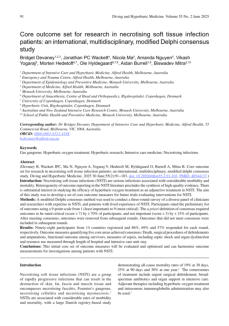First aid 2022 - Now






Authors:
Álvaro Astasio-Picado, Paula Cobos-Moreno, Beatriz
Gómez-Martín, María del Carmen Zabala-Baños, and
Claudia Aranda-Martín.
The objective of this systematic bibliographic review is to
update the theoretical and practical knowledge and
strategies for the insertion and proper management of the
intraosseous route as an emergency vascular access for
nursing professionals.



NCCD is a compact, lightweight chest compression device
to be used as a substitute to manual chest compression
during CPR.
NCCD is powered by compressed gas, and designed for
use in hyperbaric environments.
This equipment is described in logistics/medical
equipment/NUI - Compact Chest Compression Device
(NCCD
https://diving-rov-specialists.com/medical-equip.htm



Authors:
Ronal Surya Aditya, Ah Yusuf, Fitriana Kurniasari Solikhah,
Setyo Budi Kurniawan, Siti Rozaimah Sheikh Abdullah
This document discusses research aimed at understanding
nurses' experience assisting patients on stretchers using
commercial flights in Indonesia.




Authors: Jianxun Li, Haoxin Fu, Kin Keung Lai, and
Bhagwat Ram
The mobile emergency system is a new emergency mode
that provides a solution to deal with increasingly frequent
sudden disasters by reasonably allocating mobile
emergency facilities and optimizing the allocation of
mobile emergency materials. The authors consider mobile
emergency cost and mobile emergency time as two
objective functions.
This paper establishes a multi-objective mobile emergency
material allocation model, and transforms the multi-
objective.



Authors: Kara D. Wyatt, Neha N. Goel, and Jessica S.
Whittle
High flow nasal oxygen is a relatively new option for
treating patients with respiratory failure, which decreases
the work of breathing, improves the tidal volume, and
modestly increases positive end-expiatory pressure.
Despite well-described physiologic benefits, the clinical
impact of high flow nasal oxygen is still under
investigation. In this article, the authors review the most
recent findings on the clinical efficacy of high flow nasal
oxygen in Type I, II, III, and IV respiratory failure within
adult and pediatric patients.

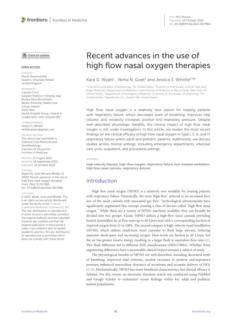

Authors: Seong-Yong Jeong, Young Kook Moon,
Joseph Wang, & Jong-Heun Lee
Accurately detecting and identification of volatile aromatic
hydrocarbons, highly toxic pollutants, are essential for
assessing indoor and outdoor air quality and protecting
humans from their sources. However, real-time and on-
site monitoring of aromatic hydrocarbons has been
limited by insufficient sensor selectivity. Addressing the
issue, bilayer oxide chemiresistors are developed using
Rh–SnO2 gas-sensing films and catalytic CeO2 overlayers
for rapidly and cost-effectively detecting traces of aromatic
hydrocarbons in a highly discriminative and quantitative
manner, even in gas mixtures.



Publisher: US Federal Aviation Administration
This document from the US Federal Aviation
Administration was initially designed for personnel
working in airline companies. Commercial diving
companies and divers can use it to understand which
formation this personnel may have or may not have.



Authors:
Joost Bierens, Janet Bray, Cristian Abelairas-Gomez,
Roberto Barcala-Furelos, Stephen Beerman, Andreas
Claesson, Cody Dunne, Tatsuma Fukuda, Muralidharan
Jayashree, Anthony T Lagina, Lei Li j, Tom Mecrow, Patrick
Morgan, Andrew Schmidt, Jeroen Seesink, Justin
Sempsrott, David Szpilman, Ogilvie Thom, Joshua Tobin,
Jonathon Webber, Samantha Johnson, Gavin D Perkins,
on behalf of International Liaison Committee on
Resuscitation BLS/AED Task Force
The International Liaison Committee on Resuscitation, in
collaboration with drowning researchers from around the
world, aimed to review the evidence addressing seven key
resuscitation interventions.



Authors: Jan Schmitz, Felix Liebold, Jochen Hinkelbein,
Sophia Nöhl, Serge Thal, and Timur Sellmann
Cardiopulmonary resuscitation (CPR) during hyperbaric
oxygen therapy (HBOT) presents unique challenges due
to limited access to patients in cardiac arrest (CA) and the
distinct physiological conditions present during hyperbaric
therapy. Despite these challenges, guidelines specifically
addressing CPR during HBOT are lacking.
This review aims to consolidate the available evidence and
offer recommendations for clinical practice in this context.



Authors:
Graham Johnson, Philip Bryson, Nicholas Tilbury,
Benjamin McGregor , Alistair Wesson, Gareth D Hughes,
Gareth R Hughes, Andrew Tabner
Chest compression often cannot be administered using
conventional techniques in a diving bell. Multiple
alternative techniques are taught, including head-to-chest
and both prone and seated knee-to-chest compressions,
but there are no supporting efficacy data. This study
evaluated the efficacy, safety and sustainability of these
techniques.



Authors:
Andrew Tabner, Philip Bryson, Nicholas Tilbury, Benjamin
McGregor, Alistair Wesson, Gareth R Hughes, Gareth D
Hughes, Graham Johnson
Provision of manual chest compressions in a diving bell
using a conventional technique is often impossible, and
alternative techniques are poorly evidenced in terms of
efficacy and sustainability. The first mechanical
cardiopulmonary resuscitation (CPR) device suitable for
use in this environment, the NUI Compact Chest
Compression Device (NCCD), has recently been designed
and manufactured. This study assessed both the efficacy of
the device in delivering chest compressions to both prone
and seated manikins, and the ability of novice users to
apply and operate it.

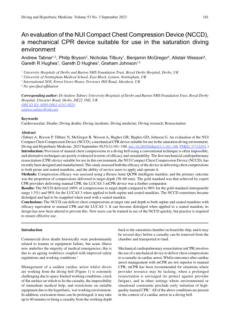

Authors:
Michele Salvagno, Federico Geraldini, Giacomo Coppalini,
Chiara Robba, Elisa Gouvea Bogossian, Filippo Annoni,
Eva Vitali, Elda Diletta Sterchele, Costantino Balestra, and
Fabio Silvio Taccone
Traumatic brain injury (TBI) and subarachnoid
hemorrhage (SAH) are critical neurological conditions
that necessitate specialized care in the Intensive Care Unit
(ICU). Managing cerebral perfusion pressure (CPP) and
mean arterial pressure (MAP) is of primary importance in
these patients. To maintain targeted MAP and CPP,
vasopressors and/or inotropes are commonly used.
However, their effects on cerebral oxygenation are not
fully understood. The aim of this review is to provide an
up-to date review regarding the current uses and
pathophysiological issues related to the use of
vasopressors and inotropes in TBI and SAH patients.



Click on the
octopus to return to
the top of the page

Authors:
Julang Fahman, Wilson Kores, Olivia Jeany Darmawan
Adji Saroso, Valerie Christianto, Cindytia Rosalina Putri
Djojomartono, Hosea Glory, Billie Edgara Herijanto, Naftali
Intania Kristianti Kosasih, Jonathan Abdiel Caesar
Nainggolan, Satria Budi Nugraha, Gabriella Putri Sabrina,
Edeline Samudra
This handbook offers essential guidance on recognizing
and handling common injuries and emergencies, as well
as performing basic life support through cardiopulmonary
resuscitation for non-professionals. Understanding that
many find it challenging to manage such situations, the
handbook includes straightforward, clear explanations
complemented by helpful images to enhance learning
and retention



Authors: Björn Jüttner, Christian Wölfel, Holger
Schöppenthau, Johannes Meyne, Carmen
Wohlrab, Henning Werr, Till Klein, Giso Schmeißer,
Karsten Theiß, Philipp Wolf, Oliver Müller, Thorsten
Janisch, Johannes Naser, Susanne Blödt, Cathleen,
Muche-Borowski
The S2k guidelines offer advice on diagnosing and
treating diving accidents. The treatment protocols for
breath-hold divers, children, and adolescents are similar.

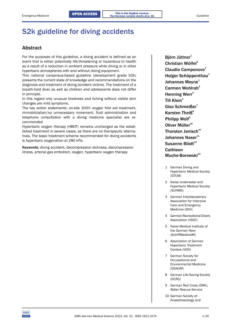

Authors: Christian Zanza , Francesco Saglietti, Gabriele
Savioli, Davide Maria Biancone, Mario Balzanelli,
Benedetta Giordano, Anna Chiara Trompeo,
Yaroslava Longhitano
This document is a comparative analysis of intranasal (IN)
analgesia versus conventional methods (intravenous, oral,
and intramuscular) for managing acute pain in the
Emergency Department (ED), which aims to evaluate the
safety, efficacy, and potential advantages of IN analgesia,
particularly focusing on drugs like fentanyl and ketamine.
Its authors also discuss the incidence and severity of
adverse events and the need for rescue analgesia,
concluding that IN analgesia could be a viable, non-
invasive, and effective alternative for pain management in
various clinical situations.

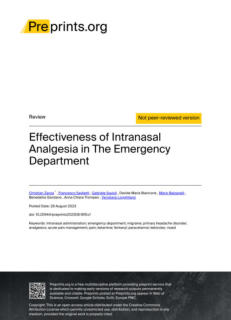

Authors:
Alberto Gabrieli, Caterina Barberi, Caterina Compostella, ,
Michela Azzolini, Andrea Butturini, Gabriele Larger, Lara
Boldo, Matteo Paganini, Roberta Levato, Andrea Ventura
This paper discusses the challenges and solutions related
to the recognition and treatment of Local Anesthetic
Systemic Toxicity (LAST) in prehospital settings,
highlighting a specific case in the Italian Alps to illustrate
the importance of effective communication and
coordination among different components of the
healthcare system. It also suggests potential operational
changes, such as creating antidote networks and
improving protocols, training, and communication to
enhance the management of LAST in emergency
situations.



Authors:
Midas N. de Grunt, Bianca de Jong, Markus W. Hollmann,
Milan L. Ridderikhof, and Robert P. Weenink
This paper discusses alternative analgesic options for
trauma patients in emergency care that have a fast onset
and can be administered through non-intravenous routes.
It also highlights the need for further research in this area.



Authors:
Matteo Paganini, Hamdi Lamine, Francesco Della Corte,
Ives Hubloue, Luca Ragazzoni, Francesco Barone-Adesi
This study aims to identify factors contributing to the
increased demand for emergency care during heatwaves
using a Delphi method involving experts to reach a
consensus on statements related to patient processing,
stakeholder identification, and potential interventions. The
findings are intended to inform future solutions to
enhance emergency healthcare resilience and reduce
disaster risk associated with climate change.

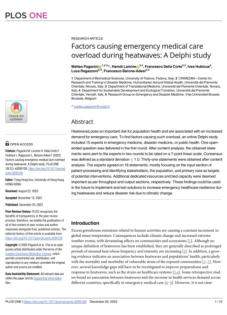

Authors:
Youichi Yanagawa , Akio Kanda, Hiroki Nagasawa,
Hiromichi Ohsaka, and Kazuhiko Omori
This authors of this paper analyze and compare the roles
and effectiveness of doctor helicopters (DHs) and disaster
medical assistance teams (DMATs) in responding to mass
casualty incidents in Shizuoka Prefecture to understand
their respective contributions and operational differences
based on past incidents and current practices.



Authors:
Matteo Paganini, Nikolaos Markou-Pappas, Francesco
Della Corte, Paolo Rosi, Giulio Trillò, Marialuisa Ferramosca,
Andrea Paoli, Federico Politi, Adriano Valerio, Andrea
Favaro, Ives Hubloue, Luca Ragazzoni, Francesco Barone-
Adesi, and Hamdi Lamine
This paper presents the findings of a multicentric study
that explores the interactions between heatwaves and
prehospital emergency medicine (PHEM) in the Veneto
Region of Northern Italy to identify how heatwaves impact
emergency healthcare systems and to propose strategies
for mitigating these effects. It highlights the perspectives of
PHEM personnel on the challenges posed by heatwaves
and suggests interventions to improve emergency medical
service (EMS) capacity and preparedness.





15 - Cardiogenic Pulmonary Edema in Emergency Medicine
Author: Christian Zanza, Francesco Saglietti, Manfredi
Tesauro, Yaroslava Longhitano, Gabriele Savioli,
Mario Giosuè Balzanelli, Tatsiana Romenskaya,
Luigi Cofone, Ivano Pindinello, Giulia Racca, and
Fabrizio Racca
Cardiogenic pulmonary edema (CPE) causes acute
respiratory failure from fluid in the lung’s alveolar spaces
due to high cardiac pressure. Cardiac diseases can lead to
CPE, with factors like inflammation and cell damage
contributing to its development. Diagnosis involves a
medical history, physical exam, and tests like chest
radiographs. Treatment includes non-invasive ventilation,
diuretics, and inotropes for symptoms, with additional
options for resistant cases. This paper reviews CPE's
causes, symptoms, and management.


Authors: Sanjay Kalra, Atul Dhingra, Kumar Abhisheka,
Nitin Kapoor
This communication discusses psychological first aid in
diabetes management. It is defined as support,
counselling, and education that helps improve coping
skills and self-care for those with diabetes. Healthcare
providers should be able to give effective psychological
first aid.


22 - Psychological First Aid



23 - First aid training using virtual reality

Authors: Burapa Phatichon and Chantana
Chantrapornchai
This work explores using virtual reality (VR) to teach first
aid training. VR creates realistic training experiences. Its
authors developed interactive first aid lessons with the
Unity engine, featuring hands-on exercises and tests.
Fourteen learners rated the lessons with an average of 9.
1 satisfaction. Knowledge scores increased by 35%, and
practical test scores improved by 22%, showing the
application’s effectiveness.




26 - Portable oxygen breathing apparatus integrated with
biosensors: Enabling intelligent monitoring and optimal oxygen
provision for biomechanical homeostasis.
Authors: Honghao Zhang
A portable oxygen breathing apparatus is a lightweight
gadget that provides extra oxygen while traveling,
essential for energy production in cells. It helps patients
with respiratory issues maintain therapy and improves
their daily lives. Poor assessment can lead to low oxygen
availability, causing potential cell damage. This study
introduces an intelligent portable oxygen device
integrated with biosensors that adjusts oxygen delivery
based on activity levels, ensuring precise patient
monitoring. The new system shows a high accuracy rate
of 98. 4%, representing a major advancement in portable
oxygen therapy.




27 - Exploring knowledge of first aid in epistaxis—25 years on
Authors: Henry DunneI, Michael Abouabdallah, Joseph
Roscamp, Samuel Birks, Kate Mcgibbon, Sam
Dewhurst, David Strachan, Rishi Sharma
A 1998 survey demonstrated widespread ignorance of
correct first aid amongst the public with only 11% of
respondents applying correct first aid techniques. The
authors repeated and expanded the 1998 study to
investigate whether understanding of correct first aid in
epistaxis amongst the public and emergency department
staff has improved in the last 25 years.




28 - Understanding First Aid Skills in Emergency Situations: A
Literature Review.
Author: Irfanita Nurhidayah, Aklima , Riski Amalia,
Mariatul Kiftia
Injuries can lead to emergencies and serious harm if not
managed well. Early emergency skills are essential to
prevent worsening conditions. This study reviews
literature on understanding basic first aid in emergencies.
It found knowledge levels range from poor to moderate.
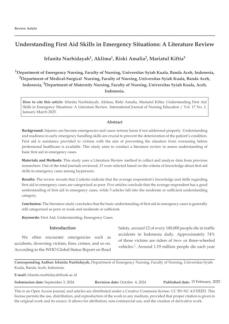



18 - Advances in Respiratory Monitoring: A Comprehensive Review
of Wearable and Remote Technologies
Author: Diana Vitazkova, Erik Foltan, Helena Kosnacova,
Michal Micjan, Martin Donoval, Anton Kuzma,
Martin Kopani, and Erik Vavrinsky
This article discusses the role of wearable and remote
technologies in healthcare, particularly for continuous
monitoring. It reviews various devices, from traditional
chest belts to advanced bioamplifiers that track breathing.
The research also covers innovative methods like
seismocardiography, ballistocardiography, and remote
camera recordings, along with acoustic techniques and
breath gas analysis. There is increasing interest from
researchers, as shown by the growing number of related
publications, which our manuscript summarizes.




20 - Reported outcome measures in necrotising soft tissue infections:
a systematic review.
Author: Jonathan Wackett, Bridget Devaney, Raymond
Chau, Joshua Ho, Nicholas King, Jasleen
Grewal, Joshua Armstrong, Biswadev Mitra
There are inconsistencies in reporting outcomes for
patients with necrotising soft tissue infections (NSTI). This
study aimed to evaluate these reported measures to
create a core outcome set. A systematic review of NSTI
literature from 2010 to 2020 identified 375 studies with
311 outcome measures. Most commonly reported
measures included mortality, hospital stay length, and
amputations. The findings emphasize the need for a
standardized core outcome set.
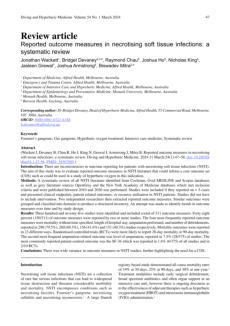



29 - Risks to the clinician of risk management: recalled and
anticipated consequences of decision-making
Author: Alexander Challinor, Sahil Bhandari, Sean Boyle,
Mark Gabbay, , Pete Wilson, Pooja Saini, and
Rajan Nathan
The study highlights that real-world clinical decision-
making in mental health is influenced by concerns about
potential threats to clinicians from adverse incidents. It
aims to understand the recalled and anticipated
consequences faced by mental health professionals when
making decisions under uncertainty. Focus groups with
various mental health practitioners revealed that
consequences are mostly negative and perceived as
originating from peer scrutiny, organizational leadership,
and patient safety systems.
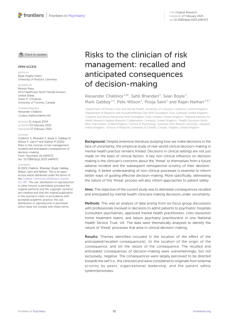



30 - Muscle regeneration is improved by hot water immersion but
unchanged by cold following a simulated musculoskeletal
injury in humans
Authors:
Valentin Dablainville, Adèle Mornas, Tom Normand-
Gravier, Maha Al-Mulla, Emmanouil Papakostas, Bruno
Olory, Theodorakys Marin Fermin, Frantzeska Zampeli,
Nelda Nader, Marine Alhammoud, Freya Bayne, Anthony
M. J. Sanchez, Marco Cardinale, Robin Candau, Henri
Bernardi, and Sébastien Racinais
Cryotherapy is commonly used for treating muscle
injuries, but its effects on muscle recovery are unclear. This
study examined how three thermal treatments—cold,
thermoneutral, and hot water immersion—affect muscle
healing. Results showed that hot water immersion
reduced pain and muscle damage markers better than
other methods, while cold water immersion did not help
recovery.
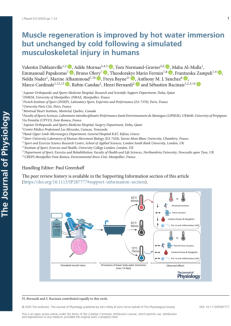



31 - Core outcome set for research in necrotising soft tissue infection
patients: an international, multidisciplinary, modified Delphi
consensus tudy

Author: Bridget Devaney, Jonathan PC Wackett, Nicola
Ma, Amanda Nguyen, Vikash Yogaraj, Morten
Hedetoft, Ole Hyldegaard, Aidan Burrell,
Biswadev Mitra
Necrotising soft tissue infections (NSTI) cause significant
health issues and require consistent outcome reporting in
studies. Researchers aimed to establish core outcome
measures using a survey of clinicians and patients. The
survey identified five key areas for consensus: death,
surgical procedures, functional outcomes, sepsis
measures, and resource use.

